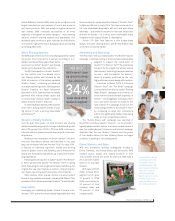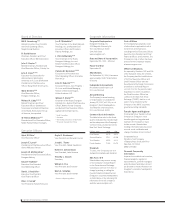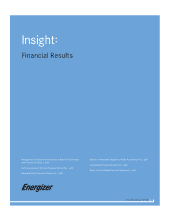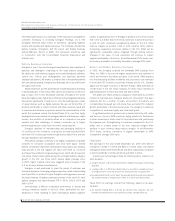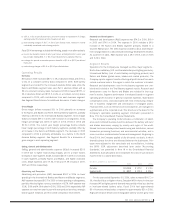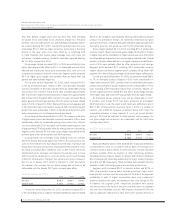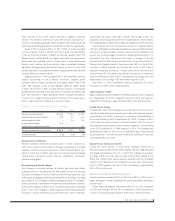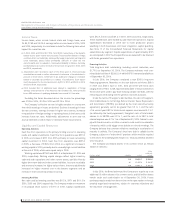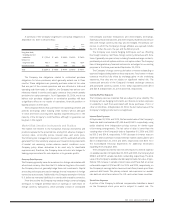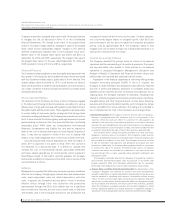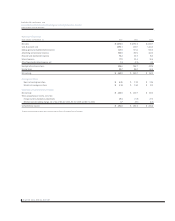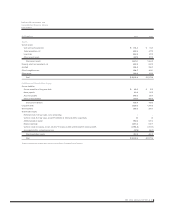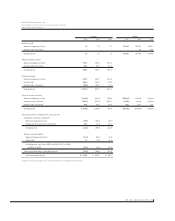Energizer 2006 Annual Report Download - page 17
Download and view the complete annual report
Please find page 17 of the 2006 Energizer annual report below. You can navigate through the pages in the report by either clicking on the pages listed below, or by using the keyword search tool below to find specific information within the annual report.
ENR 2006 ANNUAL REPORT 15
A summary of the Company’s significant contractual obligations at
September 30, 2006 is shown below:
Less More
Than 1-3 3-5 Than
Total 1 Year Years Years 5 Years
Long-term debt,
including current
maturities $ 1,710.0 $ 85.0 $ 235.0 $ 610.0 $ 780.0
Interest on
long-term debt 483.1 89.0 158.5 115.2 120.4
Operating leases 56.1 15.8 20.9 12.1 7.3
Total $ 2,249.2 $ 189.8 $ 414.4 $ 737.3 $ 907.7
The Company has obligations related to contractual purchase
obligations for future purchases, which generally extend one to three
months. These obligations are primarily purchase orders at fair value
that are part of the normal operations and are reflected in historical
operating cash flow trends. In addition, the Company has various com-
mitments related to service and supply contracts that contain penalty
provisions for early termination. As of September 30, 2006, we do not
believe such purchase obligations or termination penalties will have
a significant effect on our results of operations, financial postition or
liquidity position in the future.
The Company believes that cash flows from operating activities and
periodic borrowings under existing credit facilities will be adequate
to meet short-term and long-term liquidity requirements prior to the
maturity of the Company’s credit facilities, although no guarantee can
be given in this regard.
Market Risk Sensitive Instruments and Position
The market risk inherent in the Company’s financial instruments and
positions represents the potential loss arising from adverse changes in
currency rates, commodity prices, interest rates and stock price.
The following risk management discussion and the estimated amounts
generated from the sensitivity analyses are forward-looking statements
of market risk assuming certain adverse market conditions occur.
Company policy allows derivatives to be used only for identifiable
exposures and, therefore, the Company does not enter into hedges for
trading purposes where the sole objective is to generate profits.
Currency Rate Exposure
The Company generally views its investments in foreign subsidiaries with
a functional currency other than the U.S. dollar as long-term. As a result,
the Company does not generally hedge these net investments. Capital
structuring techniques are used to manage the net investment in foreign
currencies as necessary. Additionally, the Company attempts to limit its
U.S. dollar net monetary liabilities in countries with unstable currencies.
From time to time the Company may employ foreign currency hedging
techniques to
mitigate potential losses in earnings or cash flows on
foreign currency transactions, which primarily consist of anticipated
intercompany purchase transactions and intercompany borrowings.
External purchase transactions and intercompany dividends and service
fees with foreign currency risk may also be hedged. The primary cur-
rencies to which the Company’s foreign affiliates are exposed include
the U.S. dollar, the euro, the yen and the British pound.
The Company uses natural hedging techniques, such as offsetting
like foreign currency cash flows, foreign currency derivatives with dura-
tions of generally one year or less, including forward exchange contracts,
purchased put and call options and zero-cost option collars. The Company
has not designated any financial instruments as hedges for accounting
purposes in the three years ended September 30, 2006.
The Company’s foreign currency derivative contracts outstanding at
year-end hedge existing balance sheet exposures. Any losses on these
contracts would be fully offset by exchange gains on the underlying
exposures, thus they are not subject to significant market risk. The
contractual amounts of the Company’s forward exchange contracts
and purchased currency options in U.S. dollar equivalents were $21.3
and $30.8 at September 30, 2006 and 2005, respectively.
Commodity Price Exposure
The Company uses raw materials that are subject to price volatility. The
Company will use hedging instruments as it desires to reduce exposure
to variability in cash flows associated with future purchases of zinc or
other commodities. At September 30, 2006, the fair market value of the
Company’s hedging instruments is insignificant.
Interest Rate Exposure
At September 30, 2006 and 2005, the fair market value of the Company’s
fixed rate debt is estimated at $1,454.8 and $965.2, respectively, using
yields obtained from independent pricing sources for similar types
of borrowing arrangements. The fair value of debt is lower than the
carrying value of the Company’s debt at September 30, 2006 and 2005
by $30.2 and $34.8, respectively. A 10% decrease in interest rates on
fixed-rate debt would have increased the fair market value by $46.2 and
$30.1 at September 30, 2006 and 2005, respectively. See Note 10 to
the Consolidated Financial Statements for additional information
regarding the Company’s debt.
The Company has interest rate risk with respect to interest expense
on variable rate debt. At September 30, 2006 and 2005, the Company had
$288.6 and $411.2 variable rate debt outstanding, respectively. The book
value of the Company’s variable rate debt approximates fair value. A hypo-
thetical 10% increase in variable interest rates would have had an annual
unfavorable impact of $1.8 and $1.9 in 2006 and 2005, respectively, on
the Company’s earnings before taxes and cash flows, based upon these
year-end debt levels. The primary interest rate exposures on variable
rate debt are short-term rates in the U.S. and certain Asian countries.
Stock Price Exposure
A portion of the Company’s deferred compensation liabilities is based
on the Company’s stock price and is subject to market risk. The




